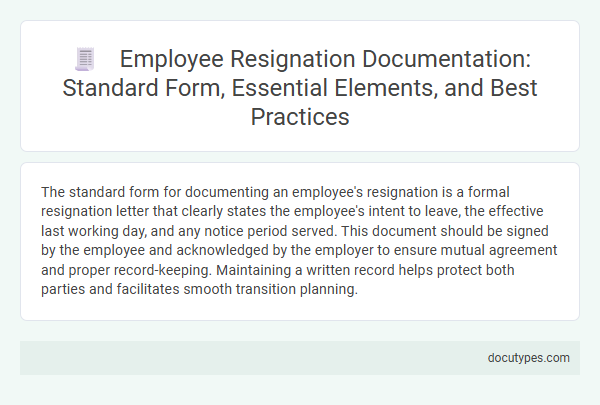The standard form for documenting an employee's resignation is a formal resignation letter that clearly states the employee's intent to leave, the effective last working day, and any notice period served. This document should be signed by the employee and acknowledged by the employer to ensure mutual agreement and proper record-keeping. Maintaining a written record helps protect both parties and facilitates smooth transition planning.
Introduction to Employee Resignation Documentation
Documenting an employee's resignation is a crucial step in maintaining clear and professional workplace records. It ensures both the employer and employee have a mutual understanding of the resignation terms and timelines.
The standard form for documenting resignation typically includes the employee's name, position, resignation date, and last working day. This formal record helps streamline the offboarding process and protects the company legally.
Importance of Proper Resignation Documentation
Documenting an employee's resignation using a standard form ensures clear communication and legal protection for both parties. Proper resignation documentation is essential for maintaining accurate HR records and facilitating a smooth transition.
- Formal Letter Format - The resignation letter should include the employee's full name, position, resignation date, and last working day to provide a clear record.
- Written Acknowledgment - Employers should issue a written acceptance of the resignation to confirm receipt and agreement on the terms.
- Compliance and Clarity - Proper documentation helps avoid misunderstandings, protects your rights, and supports compliance with labor laws and company policies.
Components of a Standard Employee Resignation Form
What are the key components of a standard employee resignation form? A standard resignation form typically includes the employee's full name, position, and department to ensure proper identification. It also features the resignation date and the effective last working day for clear record-keeping.
Why is it important to include a reason for resignation on the form? Including a reason helps employers understand the circumstances of the departure and can provide valuable feedback for improving workplace conditions. This section is usually optional but highly recommended for organizational insight.
How does an acknowledgment section contribute to the resignation process? An acknowledgment section, where the employee confirms their resignation terms and understanding of exit procedures, formalizes the process. It often requires the employee's signature and the date to validate the document legally.
Essential Elements to Include in Resignation Letters
Documenting an employee's resignation requires a standard form that clearly states the employee's intent to leave the organization. Essential elements include the employee's full name, position, resignation date, and the effective last working day. A well-structured resignation letter ensures clarity and professionalism in the transition process.
Legal Considerations in Documenting Employee Resignations
The standard form for documenting an employee's resignation typically includes the employee's name, position, effective resignation date, and a clear statement of intent to resign. This form acts as an official record confirming the voluntary termination of employment.
Legal considerations in documenting employee resignations ensure compliance with labor laws and protect both employer and employee rights. The document should be signed and dated by the employee to verify authenticity. Keeping this record helps you manage potential disputes or compliance audits effectively.
Step-by-Step Process for Managing Resignation Documentation
| Step | Action | Description |
|---|---|---|
| 1 | Receive Resignation Letter | Collect a formal resignation letter from the employee, either as a physical document or an email, stating the intent to resign and the last working day. |
| 2 | Verify Resignation Details | Confirm the employee's name, position, date of submission, and intended last day of work for accuracy and record-keeping. |
| 3 | Draft Acknowledgment Letter | Prepare a resignation acceptance or acknowledgment letter on company letterhead, affirming receipt of the resignation and outlining next steps. |
| 4 | Record Resignation in HR System | Enter the resignation details into the Human Resources Information System (HRIS) for tracking and payroll adjustments. |
| 5 | Schedule Exit Interview | Arrange an exit interview to gather feedback and discuss final procedures such as handover and return of company property. |
| 6 | Prepare Final Documentation | Generate documents including resignation acknowledgment, clearance forms, benefits summary, and final paycheck statements. |
| 7 | File and Archive Documents | Properly file all resignation-related documents in both physical and digital archives for legal compliance and future reference. |
Best Practices for Maintaining Resignation Records
Maintaining a clear and standardized form for documenting an employee's resignation ensures accurate record-keeping and legal compliance. Your resignation records should include essential details to support smooth HR processes and future reference.
- Formal resignation letter - A written letter signed by the employee stating their intent to resign and the effective last working day.
- Acknowledgment receipt - Documentation from the employer confirming receipt of the resignation letter and any agreed-upon terms.
- Exit interview summary - A record of discussions held during the exit interview, highlighting reasons for leaving and feedback.
Common Mistakes to Avoid in Resignation Documentation
The standard form for documenting an employee's resignation includes the employee's full name, resignation date, and the last working day. It also outlines the reason for leaving and any necessary handover details.
Common mistakes to avoid include vague language and missing signatures, which can lead to disputes. Failure to specify the exact resignation date and final working day causes confusion in payroll and benefits processing.
Digital Solutions for Employee Resignation Management
The standard form for documenting an employee's resignation typically includes the employee's full name, position, resignation date, and the effective last working day. Digital solutions for employee resignation management streamline this process through automated resignation forms, ensuring accuracy and easy record-keeping. These platforms often integrate with HR systems to provide real-time updates and maintain comprehensive resignation history securely.
What Is the Standard Form for Documenting an Employee's Resignation? Infographic

